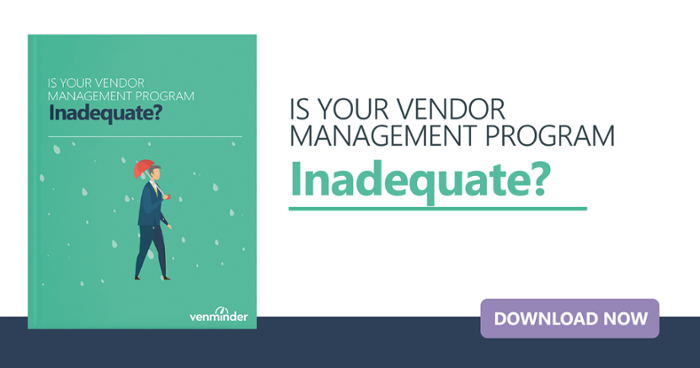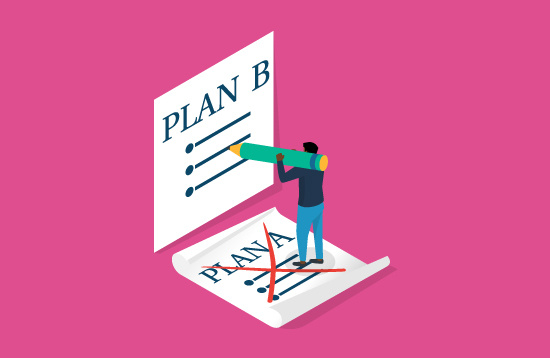There are a variety of reasons you may, at some point in the vendor lifecycle, need to have an actionable plan to replace the product or service the vendor is providing. In fact, you should have a plan in place before the situation even arises. It does seem counterintuitive in some ways to begin a relationship already envisioning the end.
Your Plan B is your backup plan and your safety net. It’s like having a rainy-day fund in case your finances take a left turn or knowing exactly where those red exit signs are in case of a fire. We have exit strategies for a lot of other sticky situations in life, and the same should be true of vendor relationships.
4 Reasons You Need a Vendor Transition Plan
Here are four good reasons why you should always have a vendor transition plan, aka Plan B, which will allow for a smooth shift should the need arise:
1. Leverage.
Without a reasonably actionable Plan B, your incumbent vendor has the upper hand in any negotiations, such as in the following scenarios:
- Contract renewals
- Adding another product or service through that vendor
- Day-to-day servicing issues
- Control of customer data
This is because vendors know in most cases organizations don’t like change. Vendor changes take a lot of time and resources. If you’re inadvertently sending signals during your negotiation that cue them in to the fact that you don’t really have a backup plan, it will be fairly obvious.
2. Acquisitions.
Ever been in this situation: You’ve made the decision to move forward with the vendor based on several factors, and then the vendor is acquired? It’s not always a bad thing, but sometimes, management changes, product direction shifts, service levels change and more begin to occur due to the acquisition.
Why can this be problematic? Many times, an acquisition gives a smaller vendor more resources and capabilities than they had before. However, in just as many cases, the speed of product innovation or the level of client input changes dramatically. Depending on your own strategy, this could pose unexpected problems, especially if you don’t have a vendor transition plan.
3. Strategic Misalignment.
Once a good fit but not always a good fit. The strategy of both you and your vendors will undoubtedly change over time. Maybe in the same direction, and sometimes not. It’s wise to keep your finger on the pulse of competing offerings throughout the lifecycle of the relationship. It’s common to get very comfortable in vendor relationships, especially the good ones.
However, without an eye toward what you could have versus what you do have, you could be missing out. Perhaps there’s just a better solution or maybe your vendor has chosen to focus their research and development investments in another area of their business. Due to our natural human resistance to change, being mentally prepared to make a change is half the battle.
4. Financial Concerns.
Innovation tends to come from earlier stage organizations in the industry (aka startup companies). Some make it, others don’t. Some take the position of not doing business with organizations under a certain financial maturity level, but the result is often not taking advantage of new innovations that can help differentiate you in the market, drive your growth or save you money. A more thoughtful approach might be to weigh the risks against the rewards, and if you choose to take that risk, manage it tightly.
Make sure to do the following 3 things:
• Monitor (regularly) for changes in financial health
• Set a threshold or tolerance level beforehand
• Watch for significant changes in management structure or products or performance
Then, should conditions fall below your established threshold, you need to build your exit strategy. You don’t necessarily have to execute on it right away, but you will need to be able to show your auditors and examiners that you have set thresholds for establishing a backup plan (as well as have documentation for next steps should you have to pull the trigger) and have executed against your policy by preparing aforementioned Plan B.
Developing a Formal Exit Strategy
It may seem a bit “doom and gloom,” but it’s important to consider what might happen if the company with whom you're doing business suddenly ceased to exist. What happens if your vendor came upon hard times and went out of business? What would happen if a catastrophic event occurred, or like in recent events, the vendor was no longer able to operate due to a massive, global shutdown or a pandemic? This is where an exit strategy comes into play.
As you develop a formal exit strategy, consider both a sudden and gradual unwind of the vendor relationship. You should be thinking about things like how your data will be destroyed or returned to you and if you'll bring the function in-house or outsource to a new vendor. Once you’ve developed your exit strategy, make sure to keep your senior management informed. Your goals should always be to minimize disruption to your business, your customers and to maintain regular service, if you need to move to a different vendor quickly.
Unfortunately, this part of vendor management often slips through the cracks because no one wants to think about the end right at the very beginning. Abe Lincoln was once quoted as saying, “Give me six hours to chop down a tree and I will spend the first four sharpening the axe.” This adage could undoubtedly be applied to endless scenarios, but when it comes to our vendor relationships the parallel is quite clear: it’s best to spend our energy sharpening our plans upfront... long before we ever get to the chopping block.
Make sure you have an adequate vendor management program. Download the eBook.







